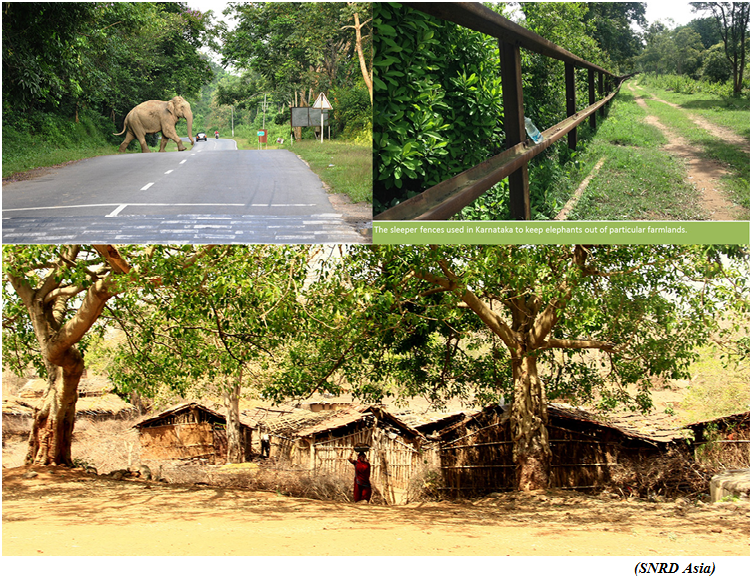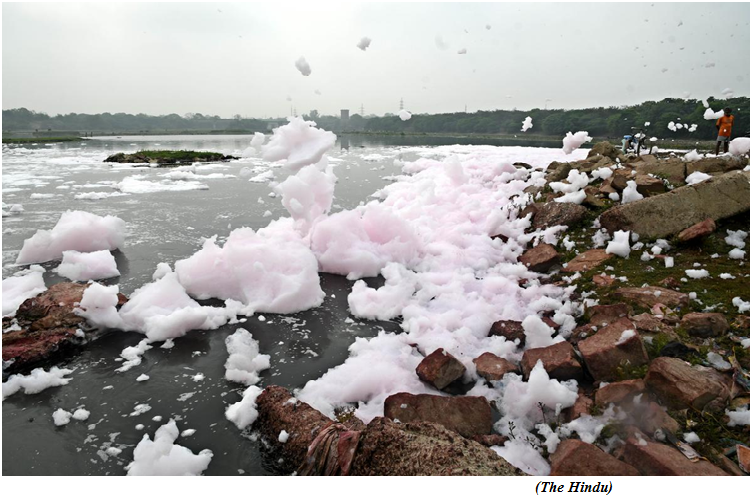Guidelines for Human Wildlife Conflict Mitigation promoting harmonious coexistence between humans and wildlife (GS Paper 3, Environment)

Why in news?
- Recently, Union Minister for Environment, Forest and Climate Change released 14 guidelines to address Human-Wildlife Conflict (HWC), which aim to facilitate a common understanding among key stakeholders, on what constitutes effective and efficient mitigation of HWC in India.
- The guidelines are advisory in nature, and will facilitate in further development of site-specific HWC mitigation measures.
- These guidelines are developed under the Indo-German cooperation project on HWC Mitigation, which is being implemented by Ministry of Environment, Forest and Climate Change (MoEFCC) together with Deutsche Gesellschaft fur InternationaleZusannenarbeit (GIZ) GmbH and state forest departments of Karnataka, Uttarakhand and West Bengal.
The 14 guidelines released include:
10 species-specific guidelines-
- Guidelines for Mitigating Human -Elephant, -Gaur, -Leopard, -Snake, -Crocodile, -Rhesus Macaque, -Wild Pig, -Bear, -Blue Bull and -Blackbuck Conflict; and
4 guidelines on cross-cutting issues-
- Guidelines for Cooperation between the Forest and Media sector in India: Towards effective communication on Human-Wildlife Conflict Mitigation
- Occupational Health and Safety in the Context of Human–Wildlife Conflict Mitigation
- Crowd Management in Human-Wildlife Conflict Related Situations
- Addressing Health Emergencies and Potential Health Risks Arising Out of Human—Wildlife Conflict Situations: Taking a One Health Approach.
Holistic approach:
- The development and intended implementation of these guidelines is driven by a harmonious-coexistence approach to ensure that both humans and wild animals are protected from the negative impacts of HWC. These guidelines are strongly driven by field experiences, and take into consideration the existing guidelines and advisories issued by various agencies and state forest departments, as well as their good practices, and build on them.
- The guidelines provide a framework to take a holistic approach, viz., not only addressing the emergency situations arising due to immediate HWC situations but also addressing the drivers and pressures that lead to HWC, guidance on establishing and managing prevention methods, and reducing the impact of conflict both on humans and wild animals.
Way Forward:
- This set of guidelines is not a static document; rather, it is a living document, where feedback from field practitioners and other wildlife experts is planned to be analysed to assess the specific elements and sections that need to undergo changes.
- A review of these guidelines is planned to take place every five years from 2023 onwards.
Understanding waste to energy plants
(GS Paper 3, Environment)
Why in news?
- The Kerala government recently announced the State’s first waste-to-energy project in Kozhikode. The planned facility is expected to be built in two years and generate about 6 MW of power.
- There are around 100 waste-to-energy projects around the country but only a handful of them are operational, due to various production and operational challenges.

What do waste-to-energy projects do?
- Waste-to-energy projects use non-recyclable dry waste to generate electricity. The process increases the State’s power generation capacity and eases the solid waste management (SWM) burden.
- Generally, solid waste in India is 55-60% biodegradable organic waste, which can be converted into organic compost or biogas; 25-30% non-biodegradable dry waste; and around 15% silt, stones, and drain waste.
- Of the non-biodegradable dry waste, only 2-3% including hard plastics, metals, and e-waste is recyclable. The remainder consists of low-grade plastic, rags, and cloth that can’t be recycled.
- This fraction of the non-recyclable dry waste is the most challenging portion of the present SWM system; the presence of these materials also reduces the efficiency of recycling other dry and wet waste.
- It is this portion that waste-to-energy plants use to generate power. The waste is combusted to generate heat, which is converted into electricity.
What is the Kozhikode project?
- Kozhikode has a population of about 6.3 lakh and generates approximately 300 tonnes per day (TPD) of waste. Of this, around 205 TPD is biodegradable and 95 TPD is non-biodegradable.
- The municipality is currently using the biodegradable material to generate organic compost in various composting plants.
- Of the non-biodegradable waste, only about 5 TPD out of the 95 TPD is recycled; the remaining non-recyclable dry waste could be used to generate power at the waste-to-energy plant.
Why do waste-to-energy plants fail?
- While waste-to-energy plants seem like a simple solution, they have several challenges en route to becoming feasible.
Improper segregation:
Cost Factor:
- The cost of generating power from waste is around ₹7-8/unit, while the cost at which the States’ electricity boards buy power from coal, hydroelectric, and solar power plants is around ₹3-4/unit.
- While State electricity boards are considering purchasing power from newer renewable energy sources like waste-to-energy, the price of the power generated needs to halve.
Other conditions:
- Finally, many waste-to-energy projects have failed because of improper assessments, high expectations, improper characterisation studies, and other on-ground conditions.
- Waste-to-energy projects can consume only non-recyclable dry waste, which is about 25% of the waste; they are expected to only use segregated non-recyclable dry waste as well, which is the only type of waste with a sufficiently high calorific value.
- But often these projects are expected to manage all types of waste generated in the city which is is not good.
Way Forward:
- Setting up waste-to-energy projects is complex and needs the full support of the municipality, the State and the people. To overcome its various challenges, the municipality must ensure that only non-biodegradable dry waste is sent to the plant and separately manage the other kinds of waste.
- Importantly, the municipality or the department responsible for SWM should be practical about the high cost of power generation, and include the State electricity department, perhaps as a tripartite agreement between the municipality, the plant operator, and the power distribution agency.
- It is also crucial to conduct field studies and learn from the experience of other projects.
26% of world lacks clean drinking water, 46% sanitation, says UN report
(GS Paper 2, Health)
Why in news?
- A new report launched on the eve of the first major UN conference on water in over 45 years says 26 per cent of the world's population doesn't have access to safe drinking water and 46 per cent lack access to basic sanitation.
- The UN World Water Development Report 2023 painted a stark picture of the huge gap that needs to be filled to meet UN goals to ensure all people have access to clean water and sanitation by 2030.

Demand of water:
- According to the report, water use has been increasing globally by roughly 1 per cent per year over the last 40 years and is expected to grow at a similar rate through to 2050, driven by a combination of population growth, socio-economic development and changing consumption patterns.
- Actual increase in demand is happening in developing countries and emerging economies where it is driven by industrial growth and especially the rapid increase in the population of cities. It is in these urban areas that you're having a real big increase in demand.
- With agriculture using 70 per cent of all water globally irrigation for crops has to be more efficient as it is in some countries that now use drip irrigation, which saves water. That allows water to be available to cities.
Water stress:
- As a result of climate change, seasonal water scarcity will increase in regions where it is currently abundant such as Central Africa, East Asia and parts of South America and worsen in regions where water is already in short supply, such as the Middle East and the Sahara in Africa.
- On average, 10 per cent of the global population lives in countries with high or critical water stress and up to 3.5 billion people live under conditions of water stress at least one month a year.
- Since 2000, floods in the tropics have quadrupled while floods in the north mid-latitudes have increased 2.5-fold.
- Trends in droughts are more difficult to establish, it said, although an increase in intensity or frequency of droughts and 'heat extremes' can be expected in most regions as a direct result of climate change.
Water pollution:
- The biggest source of pollution is untreated wastewater.
- Globally, 80 per cent of wastewater is released to the environment without any treatmentand in many developing countries it's pretty much 99 per cent.
Way Forward:
- The estimated cost of meeting the goals is somewhere between USD 600 billion and USD 1 trillion a year.
- But equally important, is forging partnerships with investors, financiers, governments and climate change communities to ensure that money is invested in ways to sustain the environment and provide potable water to the 2 billion people who don't have it and sanitation to the 3.6 million in need.
UN Water Conference:




